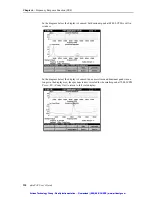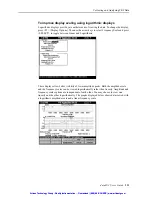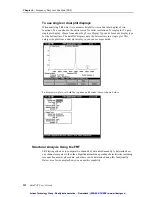
Setting Up FRF Measurements
dataPAC User’s Guide
219
Signal Processing Features of the FRF Module
The frequency response functions are measured by simultaneously sampling both the input
force and output response signals. The stored time waveform data for both channels
contains frequency, amplitude, and phase information. The frequency response and
coherence data is then computed from the Fourier transforms (auto spectrum and cross
spectrum) of the time waveform data. You can then view the stored data in any of eleven
formats. These plots include the six frequency response functions, the time waveform or
spectrum data for each channel, and a coherence plot to verify the response data correlates
directly to the input force.
The nature of frequency response testing dictates that a broad-band input signal yields the
best test results. If you sufficiently excite all frequencies in the range being measured, you
can detect all resonances in the test range. It follows that a short duration input excitation
(hammer blow) yields the widest possible frequency range excitation. However, there is a
chance that the input excitation may not last long enough to complete the output sampling
across the entire frequency range specified. If this happens, the measurement samples
random noise which may be erroneously used in the frequency response calculation. To
reduce the input signal random noise, the dataPAC applies a force window (mathematical
filter). The force window has leading and trailing cosine curves and only admits data input
for a short time immediately following the input excitation event (hammer blow).
Just as spurious background noise can be sampled on the input channel, it can also happen in
response channel sampling. In order to avoid this, the dataPAC applies an exponential decay
window to the output channel sampling. The window starts with a steep cosine filter and
ends with an exponential taper over time as the output signal fades due to structural
damping.
In order to capture the complete hammer blow event in the sampled data, the dataPAC
triggers input sampling before the hammer contacts the structure. This feature allows the
user to specify a trigger level and slope that ensures that no data is lost between the time of
hammer impact and data collection start.
Setting Up FRF Measurements
This section discusses the physical connection of hardware, instrument configuration, and
initial measurement collection. The next section covers procedures for data validation and
techniques for analyzing the test results.
Connecting the Force Hammer
Before connecting any cabling, configure the hammer with the desired mass and tip. If you
are uncertain which combination is best for the test, try starting with a mid range mass and a
plastic tip. Then switch to a different mass or steel/rubber tip as needed.
Artisan Technology Group - Quality Instrumentation ... Guaranteed | (888) 88-SOURCE | www.artisantg.com
Artisan Technology Group - Quality Instrumentation ... Guaranteed | (888) 88-SOURCE | www.artisantg.com
















































